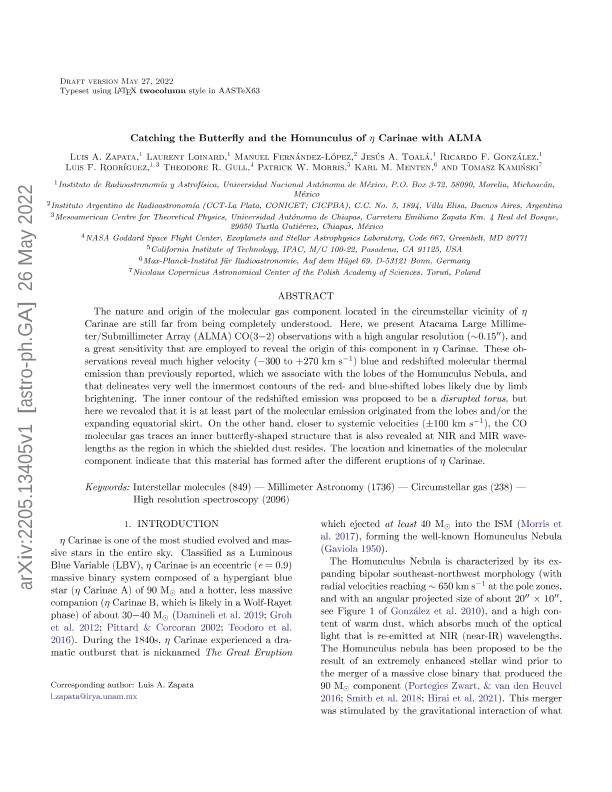Artículo
Catching the Butterfly and the Homunculus of n Carinae with ALMA
Zapata, Luis A.; Loinard, Laurent; Fernandez Lopez, Manuel ; Toalá, Jesús A.; González, Ricardo F.; Rodríguez, Luis F.; Gull, Theodore R.; Morris, Patrick W.; Menten, Karl M.; Kamiński, Tomasz
; Toalá, Jesús A.; González, Ricardo F.; Rodríguez, Luis F.; Gull, Theodore R.; Morris, Patrick W.; Menten, Karl M.; Kamiński, Tomasz
 ; Toalá, Jesús A.; González, Ricardo F.; Rodríguez, Luis F.; Gull, Theodore R.; Morris, Patrick W.; Menten, Karl M.; Kamiński, Tomasz
; Toalá, Jesús A.; González, Ricardo F.; Rodríguez, Luis F.; Gull, Theodore R.; Morris, Patrick W.; Menten, Karl M.; Kamiński, Tomasz
Fecha de publicación:
08/2022
Editorial:
IOP Publishing
Revista:
Astrophysical Journal
ISSN:
0004-637X
Idioma:
Inglés
Tipo de recurso:
Artículo publicado
Clasificación temática:
Resumen
The nature and origin of the molecular gas component located in the circumstellar vicinity of n Carinae are still far from being completely understood. Here, we present Atacama Large Millimeter/submillimeter Array CO(3-2) observations with a high angular resolution (∼0.″15) and a great sensitivity that are employed to reveal the origin of this component in n Carinae. These observations reveal much higher velocity (-300 to +270 km s-1) blue- and redshifted molecular thermal emission than previously reported, which we associate with the lobes of the Homunculus Nebula, and which delineates very well the innermost contours of the red- and blueshifted lobes likely due to limb brightening. The inner contour of the redshifted emission was proposed to be a disrupted torus, but here we reveal that it is at least part of the molecular emission originating from the lobes and/or the expanding equatorial skirt. On the other hand, closer to systemic velocities (±100 km s-1), the CO molecular gas traces an inner butterfly-shaped structure that is also revealed at near-IR and mid-IR wavelengths as the region in which the shielded dust resides. The location and kinematics of the molecular component indicate that this material has formed after the different eruptions of n Carinae.
Archivos asociados
Licencia
Identificadores
Colecciones
Articulos(IAR)
Articulos de INST.ARG.DE RADIOASTRONOMIA (I)
Articulos de INST.ARG.DE RADIOASTRONOMIA (I)
Citación
Zapata, Luis A.; Loinard, Laurent; Fernandez Lopez, Manuel; Toalá, Jesús A.; González, Ricardo F.; et al.; Catching the Butterfly and the Homunculus of n Carinae with ALMA; IOP Publishing; Astrophysical Journal; 935; 2; 8-2022; 1-13
Compartir
Altmétricas



